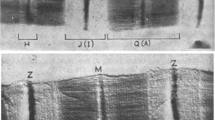Abstract
LARGE and rapid changes in the concentrations of myofibrillar protein can occur during hypertrophy and atrophy of skeletal and cardiac muscle1,2. Understanding of the regulation of these changes will require analysis of the steps between the initiation of transcription and the degradation of the protein to amino acids. The role of post-translational steps in these processes has generally been ignored since there has been no way to isolate biochemically intermediates of myofibrillar assembly. This is unfortunate since the physiological and metabolic regulation of such steps may control the rate of incorporation of new protein into this organelle, and thus the levels of functional contractile protein in the cell. Present understanding of myofibrillar assembly has come mainly from ultrastructural studies. In embryonic3, regenerating4 and rapidly growing muscles from young animals5, electron microscopy suggests that polymerised thick and thin filaments can aggregate to form myofibrils de novo and/or insert into pre-existing myofibrils. In contrast, microscopy of normal adult muscle usually does not reveal these structural aspects of myofibrillogenesis, although isotope studies showed that contractile proteins are constantly synthesised and degraded in the muscle cell1,2,6, even in the absence of net growth. This may be because only a small fraction of protein exists as nascent filaments not yet integrated into fibrillar sarcomeres, and/or because these assembly steps may be too rapid to be captured by electron microscopy. We report here the isolation of a population of thick and thin myofilaments that may constitute such an intermediate in myofibrillar assembly.
Similar content being viewed by others
References
Rabinowitz, M., Am. J. Cardiol., 31, 202–210 (1973).
Goldberg, A. L., in Cardiac hypertrophy (edit. Alpert, N.), 301–314 (Academic, New York, 1971).
Fischman, D. A., J. Cell Biol., 32, 557–575 (1967); Curr. Top. dev. Biol., 5, 235–280 (1970).
Milhorat, A. T., Shafig, S. A., and Goldstone, L., Ann. N.Y. Acad. Sci., 138, 246–292 (1966).
Williams, P. E.., and Goldspink, G., J. Cell Sci., 9, 751–767 (1971).
Dreyfus, J. C., Kruh, J., and Schapira, G., Biochem. J., 75, 574–578 (1960).
Etlinger, J. D., thesis, Univ. Chicago (1974).
Lowry, O. H., Rosebrough, N. J., Farr, A. L., and Randall, R. J., J. biol. Chem., 193, 265–275 (1951).
Maruyama, K., and Weber, A., Biochemistry, 11, 2990–2998 (1972).
Martin, A. F., Reddy, M. K., Zak, R., Dowell, R. T., and Rabinowitz, M., Circ. Res., 34, Suppl. III 111-32–111-42 (1974).
Morkin, E., Science, 167, 1499–1501 (1970).
Etlinger, J. D., and Fischman, D. A., Cold Spring Harb. Symp. quant. biol., 37, 511–522 (1973).
Rubin, I. B., and Goldstein, G., Analyt. Biochem., 33, 244–254 (1970).
Griffin, G. E., Williams, P. E., and Goldspink, G., Nature new Biol., 232, 28–29 (1971).
Author information
Authors and Affiliations
Rights and permissions
About this article
Cite this article
ETLINGER, J., ZAK, R., FISCHMAN, D. et al. Isolation of newly synthesised myosin filaments from skeletal muscle homogenates and myofibrils. Nature 255, 259–261 (1975). https://doi.org/10.1038/255259a0
Received:
Revised:
Issue Date:
DOI: https://doi.org/10.1038/255259a0
- Springer Nature Limited
This article is cited by
-
Subcellular localization of newly incorporated myosin in rabbit fast skeletal muscle undergoing stimulation-induced type transformation
Journal of Muscle Research and Cell Motility (1990)
-
Die Regulation der Herzmuskelproteinsynthese
Klinische Wochenschrift (1979)
-
Metabolism of myofibrillar proteins in the normal and hypertrophic heart
Basic Research in Cardiology (1977)
-
Phylogenic and pathological changes
Basic Research in Cardiology (1977)





